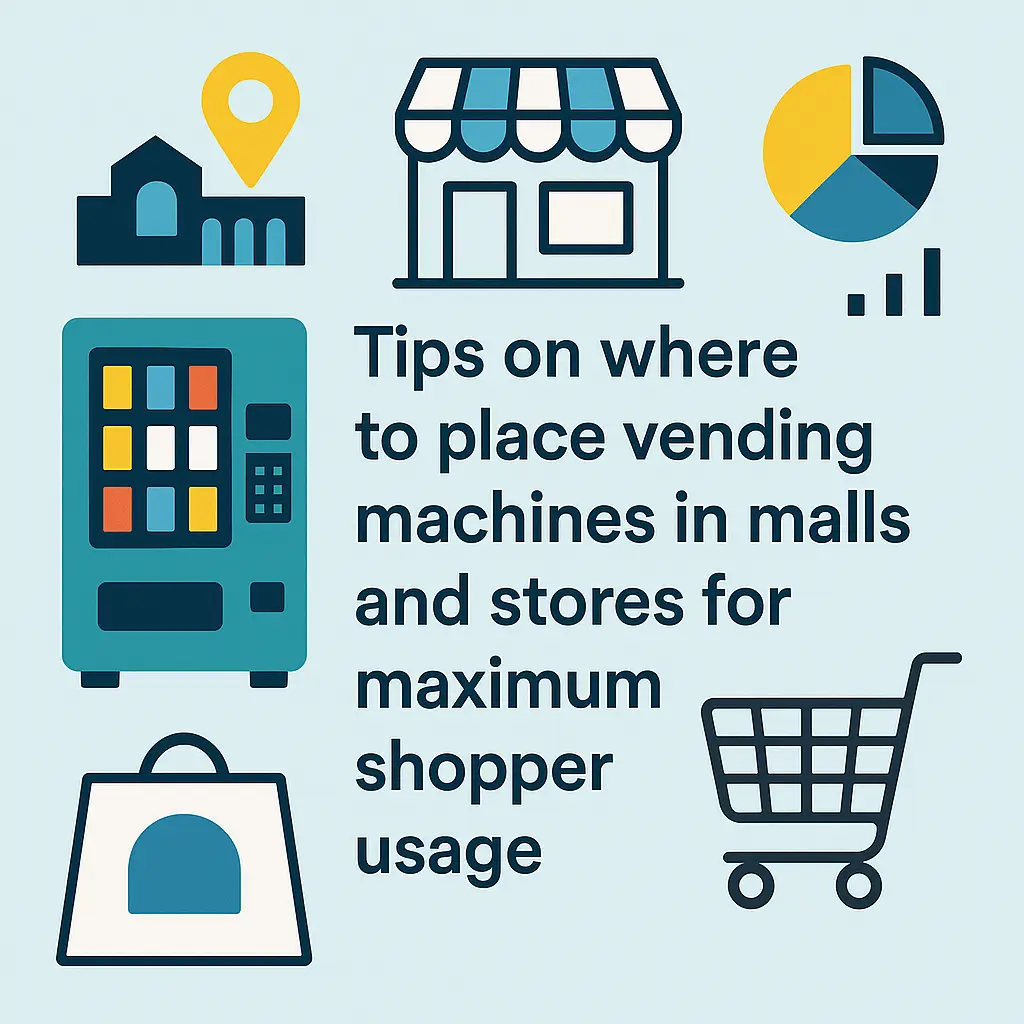Optimal Placement of Vending Machines in Retail Centers
Tips on where to place vending machines in malls and stores for maximum shopper usage.
Back to Vending for Retail Locations ResourcesTips on where to place vending machines in malls and stores for maximum shopper usage.
Back to Vending for Retail Locations ResourcesPosition machines where shoppers naturally pause or pass frequently — entrances, food courts, main concourses and near popular retailers — and tailor the product mix to the location for higher conversion.
![]() Choose high-visibility spots near main walkways and seating areas
Choose high-visibility spots near main walkways and seating areas
![]() Match product assortment to local foot traffic (families, office workers, shoppers)
Match product assortment to local foot traffic (families, office workers, shoppers)
![]() Plan for power, connectivity, ADA access and servicing to keep machines operational
Plan for power, connectivity, ADA access and servicing to keep machines operational

Effective vending placement in retail centers starts with observing customer flow. Watch where people enter, congregate, and pause — entrances, food courts, seating areas, and main concourses are consistently high-traffic zones. Positioning machines in those corridors or near checkout lanes increases visibility and impulse purchases while keeping circulation smooth. For an overview of full-service options that simplify operations, see what is full-service vending.
Prioritize areas with natural dwell time: near dining areas, seating clusters, and family or entertainment anchors. Machines placed just off main walkways but still visible from the path capture shoppers who pause to rest or check their phones. Endcaps and concourses that connect anchors usually offer consistent traffic throughout the day.
Product selection should reflect who passes the machine. Food-court adjacent units benefit from a broader snack and beverage mix, while units near fashion or electronics stores may perform well with energy drinks, bottled water, and quick convenience items. Tailoring assortments is an easy way to improve sales without changing location.
Before finalizing placement, confirm access to power, adequate clearance for deliveries, and connectivity for cashless payments and telemetry. Machines that accept cards and mobile wallets convert better in fast-moving areas — find tips on payment technologies at cashless payment options. Also ensure service staff can reach the unit easily to restock and maintain it without interrupting shoppers.
Locate machines in well-lit, visible areas, ideally near security cameras or staffed zones, to reduce vandalism and shrinkage. Anchoring units to walls, choosing tamper-resistant models, and keeping them in sightlines that staff or security patrols pass regularly helps protect assets and maintain availability.
Placement must meet ADA standards for approach, operation height, and maneuvering space. Leave clear pathways and ensure controls are reachable for customers with mobility devices. Thoughtful placement makes vending usable for more visitors and reduces obstruction complaints.
Adjust placement for holiday displays, seasonal entrances, and special events. Pop-up or portable units by seasonal attractions can capture temporary surges in foot traffic. For broader examples of venue-specific strategies, review insights from other locations like entertainment venues.
Adding vending to retail centers is a low-overhead way to enhance customer experience and capture incremental revenue. Machines require minimal onsite management when organized correctly — power, placement, and product selection drive results. For guidance on healthy product options in public settings, see healthy vending strategies.
If you're ready to evaluate locations in your retail center, fill out the short form on this page. Installation timelines are typically short once permissions and power are confirmed, and units can be tailored to match shopper needs and traffic patterns.
Main entrances, food courts, seating areas and concourses near anchor stores are top-performing locations due to steady foot traffic and dwell time.
Both matter: aim for locations that are visible from primary walkways while remaining unobtrusive to store entrances and customer flow.
Offer water, popular beverages, grab-and-go snacks, healthier options, and quick meals near dining areas; tailor stock to the surrounding customer demographics.
Yes. Plan for a standard outlet and check whether additional power or connectivity is needed for features like refrigeration or cashless payments.
Yes. Most modern machines support card and mobile payments, which increases convenience and sales—see resources on cashless payment options for details.
Place machines in staffed or well-monitored areas, use secure enclosures, anchor units, and keep them in sightlines of security cameras or personnel.
Yes. Ensure approach paths, operation heights, and clear floor space meet accessibility guidelines so all customers can use the machines.
Often yes. Coordinate with property management for permissions, placement guidelines, and any lease or permit requirements before installation.
Restocking frequency depends on traffic and product mix; high-traffic spots may need multiple visits per week, while quieter locations require less frequent servicing.
With approvals and power access, installations can often be completed in a few days to a week; planning for permissions and site prep may lengthen the timeline.